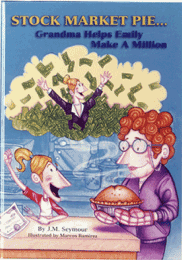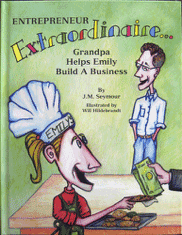Finding good money-related and entrepreneurial-minded material is time-consuming. So, to help you out, I have organized information in the following categories. These are either short articles, or a synopsis with a link to the full article.
Note the pull-down menu links to free resources for teachers and others above.
For more money-saving ideas and perspectives, go to my blog: www.moneygodmotherblog.com
Quick Facts
Quick Fact
The average American spends $1.22 for every dollar they earn. (click here for more Quick Facts)
The average American spends $1.22 for every dollar they earn. (click here for more Quick Facts)
Learning Moments
Opening a savings account
Some kids think money grows on trees.
But how are they to know differently when most don’t get to handle cash regularly or go into a bank? I recently heard a story about a 5-year-old who was slipping a deck of playing cards, one by one, into an air vent in his living room. Why? He wanted to get some money.
While a furnace vent may vaguely resemble an ATM (automatic teller machine), how would a 5-year-old know money won’t return? One skill we can teach our kids is how to use a bank or credit union, including putting money in and getting it out.
When a child can count money—generally around age seven to nine—it’s time to open a basic savings account and make regular trips to the bank. Be sure to help with filling out deposit and withdrawal slips. Watch the coin machine count change, observe what tellers do, and let a bank employee explain how the ATM works.
When kids have made many deposits and withdrawals and feel confident in using a teller, it’s time to introduce a debit card so they can use the ATM, perhaps ages 10-13. Good luck!
Some kids think money grows on trees.
But how are they to know differently when most don’t get to handle cash regularly or go into a bank? I recently heard a story about a 5-year-old who was slipping a deck of playing cards, one by one, into an air vent in his living room. Why? He wanted to get some money.
While a furnace vent may vaguely resemble an ATM (automatic teller machine), how would a 5-year-old know money won’t return? One skill we can teach our kids is how to use a bank or credit union, including putting money in and getting it out.
When a child can count money—generally around age seven to nine—it’s time to open a basic savings account and make regular trips to the bank. Be sure to help with filling out deposit and withdrawal slips. Watch the coin machine count change, observe what tellers do, and let a bank employee explain how the ATM works.
When kids have made many deposits and withdrawals and feel confident in using a teller, it’s time to introduce a debit card so they can use the ATM, perhaps ages 10-13. Good luck!
American Wealth
American Wealth
Not everyone has a bank account.
While many of us could not live without one, 60 million American adults do not have bank accounts, according to a survey by the FDIC (Federal Insurance Deposit Corp.).
Actually, more Americans lack access to basic financial services than access to health care. The FDIC survey shows that 71% of the unbanked are households earning less than $30,000/year.
Not everyone has a bank account.
While many of us could not live without one, 60 million American adults do not have bank accounts, according to a survey by the FDIC (Federal Insurance Deposit Corp.).
Actually, more Americans lack access to basic financial services than access to health care. The FDIC survey shows that 71% of the unbanked are households earning less than $30,000/year.
Quotable Quote
Quotable Quote
Albert Einstein said,
“The eighth wonder of the world is compound interest.”
Time is a great friend for patient stock market investors, who benefit from “compounding.” The magic of compounding happens when you don’t touch your original investment and let returns add up. For example, if you invest $500 a year (about $12.50 a day) at a 10 percent annual return, you would have over $10,000 after 11 years. Invest $1,000 a year at a 10% return, and you accumulate $10,000 in just 7 years. That is equal to more than $1 million in 48 years.
Investing sooner gives your nest egg more time to grow and compound, too, just like magic.
Albert Einstein said,
“The eighth wonder of the world is compound interest.”
Time is a great friend for patient stock market investors, who benefit from “compounding.” The magic of compounding happens when you don’t touch your original investment and let returns add up. For example, if you invest $500 a year (about $12.50 a day) at a 10 percent annual return, you would have over $10,000 after 11 years. Invest $1,000 a year at a 10% return, and you accumulate $10,000 in just 7 years. That is equal to more than $1 million in 48 years.
Investing sooner gives your nest egg more time to grow and compound, too, just like magic.
Articles by MGM
7 Tips to Teach Good Shopping Habits
Spending comes naturally for most of us, and even though the holidays are gone, shopping is still a perfect learning moment if you want to teach kids that buying decisions should involve time to think and evaluate. (That's why it's called holiday shopping and not spending.)
Here are 7 tips I like to give those who are teaching kids good shopping habits:
1) Follow Santa's lead: Make a list and check it twice.
Shopping with a list is more efficient, and keeps us on track...and on budget. Kids (and some adults) might even go so far as organizing by the envelope system. Just label envelopes, one for each person you want to give a gift. Put the amount to spend in each envelope, and on the envelope write individual gift ideas, prices and places to purchase. Then, when purchased, place the receipt in the envelope.

Spending comes naturally for most of us, and even though the holidays are gone, shopping is still a perfect learning moment if you want to teach kids that buying decisions should involve time to think and evaluate. (That's why it's called holiday shopping and not spending.)
Here are 7 tips I like to give those who are teaching kids good shopping habits:
1) Follow Santa's lead: Make a list and check it twice.
Shopping with a list is more efficient, and keeps us on track...and on budget. Kids (and some adults) might even go so far as organizing by the envelope system. Just label envelopes, one for each person you want to give a gift. Put the amount to spend in each envelope, and on the envelope write individual gift ideas, prices and places to purchase. Then, when purchased, place the receipt in the envelope.







